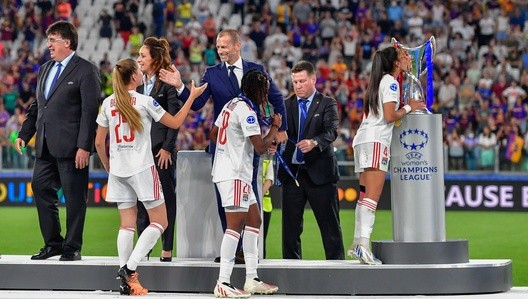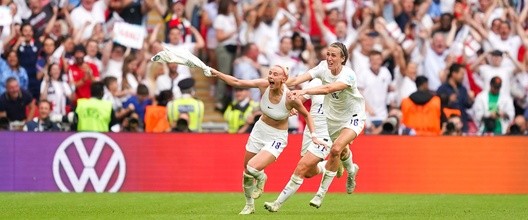
29 September 2022 - 2:46 PM
Alamy
Titans of European football talk up investment opportunities in women’s game
- Presidents of UEFA and ECA/PSG used recent public appearances to talk up the investment potential of women’s football.
- “You don’t lose money if you invest in women’s football,” says Aleksander Čeferin. His comments come after UEFA research predicts a sixfold increase in commercial value of women’s game.
- Why it matters: Lots of anecdotal evidence is often presented to make a case for women’s football, but rarely is a case presented that there is money to be made from the women’s game.
- The perspective: Because they are often tied to traditional clubs in Europe, ascertaining valuations for women’s teams in Europe is challenging. But in the US values of $50 million and $100 million have been placed in the past year.
It was a routine stop on the autumn football calendar, a sports business conference at which leaders in the game talk up the latest big ideas and trends, which are, in sum, not always that interesting.
But when the two most powerful men in European football appeared via video link an hour apart at Lisbon’s Football Talks conference earlier this month, the UEFA president Aleksander Čeferin, and the multi-hatted Nasser Al-Khelaifi (president of PSG, the European Club Association and Bein Sport) both had something really interesting to say about women’s football.
Yes, the women’s game was on the rise, they both said. Yes, it was a good thing for all of football. Yes, the Euros were great. But underlying all those positive things was a reality few at such a high level in the game have broached before. There is money to be made from the women’s game.
“I think that the most important thing is that we understand that with women's football … you don't lose money if you invest,” said Čeferin. “It's worth investing. And to be honest, the products that you invest into - that means for the broadcasters and the sponsors – it is relatively cheap to invest in women's football right now. I'm sure if you invest in women's football that is good.”
An hour later, Al-Khelaifi in front of PSG branding and in his AirPods took to the stage via video. Did he think it was foreseeable that in the next few years there will be a large profit made from women’s football?
“Absolutely,” the Qatari replied without missing a beat. “But you know, we need to be realistic. I think it will take a little bit of time. Now that most of the European top clubs start to invest, we need to have a very competitive Champions League and a very competitive euros. Now we need to start investing more, start to have the infrastructure for women.” This extended to youth teams and proper talent development, he added.

Photo:
Alamy | A successful European Championship has only increased the rise of women's football further.
“I'm really enthusiastic about it,” he added. “But we need really to focus more. It will take time, we need to be patient for sure. We need to be focussed and we can definitely bring it up to a big level.”
Vast increases
According to research by UEFA, women’s football in Europe has a current commercial value of €116 million, more than half of which (€69 million) is driven by sponsorship. They see seismic changes ahead: a sixfold increase in overall value in the next decade. Even allowing for its base case, UEFA foresee a 500 per cent increase in value in the women’s game.
At the heart of these leaps in value are an eleven fold increase in matchday revenues and a seven fold increase in sponsorship. Part of the potential comes from the low starting point, but equally the women’s game seems to be on the cusp of something bigger. 70 per cent of leagues broadcast at least one game per season (with over 50 per cent of matches aired on digital and OTT platforms), and there has been a significant upswing in major broadcast deals over the past year both in volume and value.
Two leagues already broadcast all their matches on TV and it seems as if other markets will follow. Nearly half of current broadcast deals in Europe are worth in excess of €100,000. This may seem insignificant, but it was less than one in ten just a few years ago.
Sponsor value
Relative to the overall income of the women’s game, sponsorship already plays a significant role. But again, this area remains ripe for opportunity. Just 38 per cent of leagues have a title sponsor. Most club sponsorship deals are only a year long. Only half of clubs with men’s and women’s teams integrate sponsorship deals across brands.
“Sponsorship has seen exponential growth in recent years – currently the majority of our women’s team sponsors come from partners that also back the men’s team, but we are seeing more brands that want an association with just the women’s team,” Omar Berrada, Manchester City’s CFO, has said. “We have to remain flexible on each deal to find the optimal structure across our properties.”
Jesper Koster, a director of Spar Nord, which has a long standing relationship with women’s football in Denmark said in a recent UEFA-backed report that more sponsors need to get involved “for the tide to raise all boats.” He believes that “more investment into the game will improve the product and its future potential commercialisation.”
UEFA’s own research highlights differentiation and player power as key qualities that will lure more sponsors to the women’s game. The women’s game “Stands out really well in a less crowded space,” say UEFA. “Allowing sponsors to really own the sponsorship and not get lost in the noise.” Players are more relatable and involved, “which makes it easier to generate interest and awareness. “
“We are always looking to invest more in women’s sport – you get so much more value,” says Koster. “We can align with the sport’s strong social message and the players are much more involved too, which makes activation much easier.”
Growing professionalisation
UEFA describes growing commercialism of the women’s game as “a huge step towards the wider professionalisation and development of the game”. But what is stark about the women’s game are the low entry costs. UEFA estimate the annual cost of establishing a women’s team in a tier one country at just €669,000. In tier two and three countries this drops to €353,000 and just €41,000. Annual budgets stand at €1.2 million, €416,000 and €95,000 respectively.
“In the early years, there will be losses to reach a certain level and become successful, Jean-Michel Aulos, the Olympique Lyonnais president, was quoted in The Business Case for Women’s Football. “Over time, the investment will create excellent value for the club through new partners and a differentiated fan base.”
Return on investment
Quantifying that return on investment in such a rapidly growing area is, nevertheless, difficult. Scarcely a month seems to pass without the publication of a report talking up the virtuous cycle of investment in women’s football, how it boosts overall brand value, how it is part of the “DNA” of a club, and so on. But what does this actually mean in actual impact on enterprise values?
Because the majority of women’s teams in Europe are part of a bigger club structure, segmenting that value is not straightforward. Many clubs financial statements make no reference to the women’s teams at all.
To get an idea of the value potential of women’s football, one must cast their eyes across the Atlantic, where many National Women’s Soccer League clubs are run separately from their male counterparts.
NWSL franchise Angel City raised investment in April 2021 on an enterprise value of $100 million, Sportico reported last month. The valuation, which raised money from 100 investors, was more than double the next closest known women’s football franchise. An investment group paid $35 million for Washington Spirit in February and Gotham City were reportedly valued at $40 million.
Angel City are more developed than virtually any women’s club in the world – with commercial deals worth more than most MLS clubs, and average attendances of 19,000 (more than nearly half of MLS franchises) – but it offers a glimpse into where many predict the women’s game going.
Capitalising on momentum
“Women’s football is on an incredibly exciting trajectory, with growth being seen across nearly every metric and across all of our stakeholders across Europe,” said Nadine Kessler, UEFA’s head of women’s football, last month in the preface to UEFA’s report, The Business Case for Women’s Football.
“The potential of the women’s game is limitless and we believe we are on course to take women’s football to heights that were unimaginable just a few years ago.”
She outlined how professionalisation was the key to improving standards, raising interest, and increasing financial distribution. She detailed how changes to the women’s Champions League had helped achieve this.
“It is a catalyst for change for the game in Europe, but we cannot stop there,” she said. “Now is the time to capitalise on the momentum we have created together, now is the time to get involved and invest.”